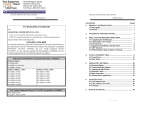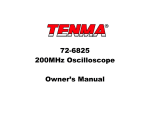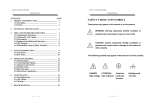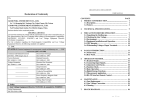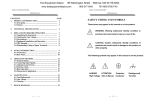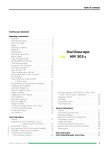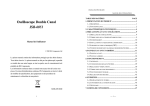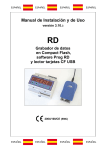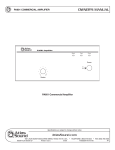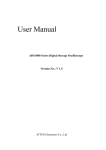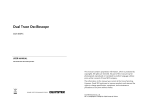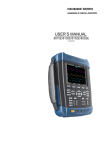Download User manual
Transcript
GOS-6051/6050/6031/6030 OSCILLOSCOPE GOS-6051/6050/6031/6030 OSCILLOSCOPE USER MANUAL USER MANUAL CONTENTS PAGE 1. PRODUCT INTRODUCTION................................................. 1 1-1.Description………………………………………………. 1 1-2.Feature………………………………………………….... 2 2. TECHNICAL SPECIFICATIONS………………………… 4 3. PRECAUTIONS BEFORE OPERATION…….…………... 3-1.Unpacking the Oscilloscope……………….………….… 3-2.Checking the Line Voltage…………………..………….. 3-3.Environment……………………………………..……… 3-4.Equipment Installation and Operation……………….... 3-5.CRT Intensity…………………………………………… 3-6.Withstanding Voltage of Input Terminals……………... SAFETY TERMS AND SYMBOLS These terms may appear in this manual or on the product: WARNING. Warning statements identify condition or 4. 7 7 7 8 8 8 8 PANEL INTRODUCTION……………………..…………... 8 4-1.Front Panel………………………………………………. 11 4-2.Rear Panel……………………………………….………. 26 5. OPERATION METHOD………………………………...…. 28 5-1.Readout Display……………………………………..…... 28 5-2.Connecting Input Signals..……………………………… 30 5-3.Adjustment and Checks………………………………… 31 5-4.Function Check…..……………………………………… 33 5-5.Basic Operation………….….………………………….... 35 5-6.Measurement Application………………………………. 44 6. MAINTENANCE…………………………………………… 6-1.Fuse Replacement……………………………………….. 6-2.Line Voltage Conversion……………………………..…. 6-3.Cleaning…………………………………………………. 7. BLOCK DIAGRAM………………………………………... 48 ⎯ i ⎯ 46 46 46 47 practices that could result in injury or loss of life. CAUTION. Caution statements identify conditions or practices that could result in damage to this product or other property. The following symbols may appear in this manual or on the product: DANGER ATTENTION Protective High Voltage refer to Manual Conductor Terminal ⎯ ii ⎯ Earth(ground) Terminal GOS-6051/6050/6031/6030 OSCILLOSCOPE USER MANUAL FOR UNITED KINGDOM ONLY NOTE: This lead/appliance must only be wired by competent persons WARNING: THIS APPLIANCE MUST BE EARTHED IMPORTANT: The wires in this lead are coloured in accordance with the following code: Green/ Yellow: Blue: Brown: GOS-6051/6050/6031/6030 OSCILLOSCOPE USER MANUAL equipment and/or user instructions for details. As a guide, cable of 0.75mm2 should be protected by a 3A or 5A fuse. Larger conductors would normally require 13A types, depending on the connection method used. Any moulded mains connector that requires removal /replacement must be destroyed by removal of any fuse & fuse carrier and disposed of immediately, as a plug with bared wires is hazardous if a engaged in live socket. Any re-wiring must be carried out in accordance with the information detailed on this label. Earth Neutral Live (Phase) As the colours of the wires in main leads may not correspond with the colours marking identified in your plug/appliance, proceed as follows: The wire which is coloured Green & Yellow must be connected to the Earth terminal marked with the letter E or by the earth symbol or coloured Green or Green & Yellow. The wire which is coloured Blue must be connected to the terminal which is marked with the letter N or coloured Blue or Black. The wire which is coloured Brown must be connected to the terminal marked with the letter L or P or coloured Brown or Red. If in doubt, consult the instructions provided with the equipment or contact the supplier. This cable/appliance should be protected by a suitably rated and approved HBC mains fuse: refer to the rating information on the ⎯ iii ⎯ ⎯ iv ⎯ GOS-6051/6050/6031/6030 OSCILLOSCOPE USER MANUAL GOS-6051/6050/6031/6030 OSCILLOSCOPE USER MANUAL Declaration of Conformity 1.PRODUCT INTRODUCTION We GOOD WILL INSTRUMENT CO., LTD. No.7-1, Jhongsing Road, Tucheng City, Taipei County 236, Taiwan 1-1. Description GOOD WILL INSTRUMENT (SUZHOU) CO., LTD. No.69 Lushan Road, Suzhou New District Jiangsu, China. The GOS-6051/50/31/30 series are 50MHz/30MHz, two-channel, portable declares that the below mentioned product GOS-6051/6050, GOS-6031/6030 are herewith confirmed to comply with the requirements set out in the Council Directive on the Approximation of the Law of Member States relating to Electromagnetic Compatibility (89/336/EEC, 92/31/EEC, 93/68/EEC) and Low Voltage Equipment Directive (73/23/EEC, 93/68/EEC). For the evaluation regarding the Electromagnetic Compatibility and Low Voltage Equipment Directive, the following standards were applied: oscilloscopes for general purpose use. A microprocessor-based operating system ◎ EMC without restriction. controls most of the functions of the instrument, including cursor readout and digitized panel setting. On-screen alphanumeric readout and cursor function for voltage, time and frequency measurement provide extraordinary operational convenience. It also has the function of auto measurement for frequency and counter. Ten different user defined instrument settings can be saved and recalled EN 61326-1: Electrical equipment for measurement, control and laboratory use –– EMC requirements (1997+A1: 1998) Conducted and Radiated Emission Electrostatic Discharge EN 55011: 1998 Group I class A IEC 61000-4-2: 1995 Current Harmonic Radiated Immunity IEC 61000-3-2: 1995 IEC 61000-4-3: 1995 Voltage Fluctuation Electrical Fast Transients IEC 61000-3-3: 1994 IEC 61000-4-4: 1995 Surge Immunity ------------------------IEC 61000-4-5: 1995 Conducted Susceptibility ------------------------IEC 61000-4-6: 1996 Power Frequency Magnetic Field ------------------------IEC 61000-4-8: 1993 Voltage Dips/ Interrupts ------------------------IEC 61000-4-11: 1994 The vertical deflection system has two input channels. Each channel has 14 basic deflection factors from 1mV to 20V per division. The horizontal deflection system provides sweep time from 0.5s to 0.2μs per division. The trigger system provides stable triggering over the full bandwidth of the vertical deflection system. ◎ Safety Low Voltage Equipment Directive 73/23/EEC & amended by 93/68/EEC Safety Requirements IEC/EN 61010-1: 2001 ⎯ ⎯ v ⎯ 1 ⎯ GOS-6051/6050/6031/6030 OSCILLOSCOPE GOS-6051/6050/6031/6030 OSCILLOSCOPE USER MANUAL USER MANUAL 7) CH1 Signal Output 1-2.Features Additionally, the oscilloscope offers several other features: The CH1 signal output is obtained by branching the input signal in the 1) High intensity and internal graticule CRT middle of the signal line. As the connector outputs the input signal at a The oscilloscope employs a high intensity 6-inch retangular type cathode- rate of 50mV/div, connecting a frequency counter makes it possible to ray tube with red internal graticule. It displays clear readable traces even at measure the frequency of a very low signal while observing its waveform. high sweep speeds. Internal graticule lines eliminate parallax-viewing error For applying a blanking signal from an external source. The trace displayed between the trace and the graticule line. on the screen may be intensity-modulated where pulse signal or time-scale 2) Frequency Counter (GOS-6051/6031) A built-in 6 digits frequency counter is accurate within the range of 0.01% measuring frequency between 1kHz to 30/50MHz and 8) Z-axis intensity modulation ± ±0.05% marks are required. 9) LED indicator and buzzer alarm The LED’s located in the front panel assist operation and indicated measuring 50Hz to 1kHz. additional information. Incorrect operation and the electrical end position 3) ALT-MAG Function The primary sweep waveform along with the magnified sweep waveform can be displayed simultaneously using the ALT-MAG function. The of control knobs are indicated by a warning beep. 10) SMD manufacturing technology magnification ratio can be selected from among three stages of ×5, ×10, × The instrument is built by using the most advanced SMD technology so as 20 for magnifying the displayed waveform in the center of the CRT. to reduce the number of internal wiring and shorten the foil route on the pc 4) Convenient VERT-MODE Triggering The sync signal source is decided automatically when vertical axis mode is switched. This means that you need not change the trigger source every time you switch the VERT-MODE. board. This will also greatly increase the high frequency performance and the reliability of the product. 11) Compact size (275W×130H×370D)mm and front panel layout groups for easyto-use. 5) TV triggering Exclusive TV sync separator circuit technology provides stable TV signal measurements on fields, frames and lines. 6) Hold Off The function allows the obtaining of stable synchronization for even complex waveforms that are difficult to synchronized by adjusting the trigger level alone. ⎯ 2 ⎯ ⎯ 3 ⎯ GOS-6051/6050/6031/6030 OSCILLOSCOPE GOS-6051/6050/6031/6030 OSCILLOSCOPE USER MANUAL 2.TECHNICAL SPECIFICATIONS CRT VERTICAL SYSTEM 6-inch rectangular type with internal graticule; Type 0%, 10%, 90% and 100% markers. 8 x 10 DIV (1 DIV = 1 cm) Accelerating Potential Approx. 10kV (GOS-6051/6050), 2kV (GOS-6031/6030) INTEN and FOCUS Front panel control. Illumination Provided (GOS-6051/6031) Trace Rotation Provided. Z-axis Input Sensitivity: at least 5V Polarity : positive going input decrease intensity Usable frequency range: DC to 2MHz. Max. input voltage: 30V (DC +AC peak) at 1kHz or less. Input Impedance: approx. 33kΩ(GOS-6051/6050) 47kΩ(GOS-6031/6030) Sensitivity Accuracy 1mV~2mV/DIV ± 5%, 5mV~20V/DIV ± 3%, 14 calibrated steps in 1-2-5 sequence. Vernier Vertical Continuously variable to 1/2.5 or less of panel Sensitivity indicate value. GOS-6051/6050 Bandwidth(-3dB) Rise Time 5mV~20V/DIV DC~50MHz Approx. 7ns 1mV~2mV/DIV DC~7MHz Approx. 50ns Bandwidth(-3dB) and Rise Time GOS-6031/6030 Bandwidth(-3dB) Rise Time 5mV~20V/DIV DC~30MHz Approx. 11.7ns 1mV~2mV/DIV DC~7MHz Approx. 50ns Maximum Input Voltage 400V (DC + AC peak) at 1kHz or less. Input Coupling AC, DC, GND Input Impedance Approx. 1MΩ±2% // approx. 25pF Vertical Modes CH1, CH2, DUAL(CHOP/ALT), ADD, CH2 INV. CHOP Frequency Approx. 250kHz. GOS-6051/6050: 6DIV at 50MHz, Dynamic Range GOS-6031/6030: 8DIV at 20MHz, 6DIV at 30MHz ⎯ 4 ⎯ USER MANUAL 0.2μs/DIV~0.5s/div, 20 steps selectable in 1-2-5 sequence, continuous variable control between steps at least 1:2.5. Accuracy ±3%, ±5% at ×5 and ×10 MAG, ±8% at ×20 MAG HORIZONTAL Sweep Magnification ×5, ×10, ×20 MAG GOS-6051/6050:20ns/DIV(10ns/DIV uncalibrated) SYSTEM Maximum Sweep Time GOS-6031/6030:50ns/DIV(10ns/DIV~40ns/DIV (at MAG) uncalibrated. ALT-MAG Function Available. Trigger Modes AUTO, NORM, TV TRIGGER Trigger Source VERT-MODE, CH1, CH2, LINE, EXT. SYSTEM Trigger Coupling AC, HFR, LFR, TV-V(-), TV-H(-). Trigger Slope “+” or “- ” polarity. GOS-6051/ CH1, VERTEXT GOS-6050 CH2 MODE 20Hz~5MHz 0.5 DIV 2.0 DIV 200mV 5MHz~40MHz 1.5 DIV 3.0 DIV 800mV 40MHz~50MHz 2.0 DIV 3.5 DIV 1V GOS-6031/ CH1, VERTTrigger Sensitivity EXT GOS-6030 CH2 MODE 20Hz~2MHz 0.5 DIV 2.0 DIV 200mV 2MHz~20MHz 1.5 DIV 3.0 DIV 800mV 20MHz~30MHz 2.0 DIV 3.5 DIV 1V TV sync pulse more than 1 DIV (CH1, CH2, VERTMODE) or 200mV (EXT). Input impedance: Approx. 1MΩ//25pF(AC External Trigger Input coupling) Max. input voltage: 400V (DC + AC peak) at 1kHz. Hold-off Time Variable. Input X-axis : CH1, Y-axis : CH2 Sensitivity 1mV/DIV~20V/DIV. X-Y Bandwidth X-axis: DC~500kHz (-3dB) OPERATION Phase Difference 3°or less from DC to 50kHz Voltage : approx. 20mV/DIV (with 50Ω CH1 Signal Output terminal.) OUTPUT Bandwidth: 50Hz to at least 5MHz. SIGNAL Voltage : 0.5V±3%, Calibrator output Frequency: approx. 1kHz, square wave. Sweep Time ⎯ 5 ⎯ GOS-6051/6050/6031/6030 OSCILLOSCOPE GOS-6051/6050/6031/6030 OSCILLOSCOPE USER MANUAL USER MANUAL Panel Setting Display Panel Setting Save & Recall Cursor Measurement (GOS-6051/6031) CRT READOUT Frequency Counter (GOS-6051/6031) CH1/CH2 sensitivity, sweep time, trigger condition 10 sets.(GOS-6051/6031) Cursor Measurement Function: ΔV, ΔT, 1/ΔT. Cursor Resolution: 1/25 DIV. Effective Cursor Range: Vertical:±3 DIV, Horizontal: ±4 DIV Display Digits: Max. 6-digits decimal. Frequency Range: 50Hz~50MHz (GOS-6051) 50Hz~30MHz (GOS-6031) Accuracy: ±0.05%: 50Hz~1kHz. ±0.01%: 1kHz~30/50MHz. Measuring Sensitivity: The satisfied value of the above-mentioned Trigger Sensitivity plus 1 DIV. (measuring source selected from CH1 or CH2 as synchronous signal source). AC100V, 120V, 230V ±10% selectable. 50Hz or 60Hz. Approx. 60VA, 50W(max). 275(W)×130(H)×370(D) mm. 8 kg Voltage LINE POWER Frequency REQUIREMENT Power Consumption MECHANICAL Dimensions SPEC. Weights OPERATING Indoor use ENVIRONMENT Altitude up to 2000 m Ambient temperature : To satisfy specifications : 10℃ to 35℃ ( 50° F to 95°F ) Maximum operating ranges: 0℃ to 40℃( 32°F to 104°F ) Relative humidity: 85% RH(max.) non condensing Installation Category : II Pollution degree 2 STORAGE TEMPERATUR -10° to 70℃, 70%RH(maximum) E & HUMIDITY Power cord….............……….. 1 ACCESSORIES Instruction manual…………… 1 Probe (×1/×10)…………..….... 2 Measurement category I is for measurements performed on circuits not directly connected to MAINS. Measurement category II is for measurements performed on circuits directly connected to the low voltage installation. Measurement category III is for measurements performed in the building installation. Measurement category IV is for measurements performed at the source of the low-voltage installation. ⎯ 6 ⎯ 3.PRECAUTIONS BEFORE OPERATION 3-1.Unpacking the Oscilloscope The product has been fully inspected and tested before shipping from the factory. Upon receiving the instrument, please unpack and inspect it to check if there is any damages caused during transportation. If any sign of damage is found, notify the bearer and/or the dealer immediately. 3-2.Checking the Line Voltage The oscilloscope can be applied any kind of line voltage shown in the table below. Before connecting the power plug to an AC line outlet, make sure the voltage selector of the rear panel is set to the correct position corresponding to the line voltage. It might be damaged the instrument if connected to the wrong AC line voltage. WARNING. To avoid electrical shock the power cord protective grounding conductor must be connected to ground. When line voltages are changed, replace the required fuses shown as below: Line voltage Range 100V 90-110V 120V 108-132V Fuse Line voltage Range Fuse T 1A250V 230V 207-250V T 0.4A250V WARNING. To avoid personal injury, disconnect the power cord before removing the fuse holder. ⎯ 7 ⎯ GOS-6051/6050/6031/6030 OSCILLOSCOPE GOS-6051/6050/6031/6030 OSCILLOSCOPE USER MANUAL USER MANUAL 4. PANEL INTRODUCTION 3-3.Environment The normal ambient temperature range of this instrument is from 0° to 40°C After the instrument is switched on, all the important settings are displayed in (32° to 104°F). To operate the instrument over this specific temperature range the readout. The LED’s located on the front panel assist operation and indicate may cause damage to the circuits. additional information. Incorrect operation and the electrical end positions of Do not use the instrument in a place where strong magnetic or electric field control knobs are indicated by a warning beep. exists as it may disturb the measurement. 3-4.Equipment Installation, and Operation All of the pushbuttons, VOLTS/DIV control knobs, TIME/DIV control knobs Ensure there is proper ventilation for the vents in the oscilloscope case. If the are electronically selected, and their functions and settings can therefore be equipment is used not according to the specification, the protection provided stored. by the equipment may be impaired. The front panel is subdivided into four sections: 3-5.CRT Intensity To prevent permanent damage to the CRT phosphor, do not make the CRT z Display controls trace brighten excessively or leave the spot stay for an unreasonably long time. z Vertical controls z Horizontal controls z Trigger controls 3-6.Withstanding Voltages of Input Terminals The withstanding voltages of the instrument input terminals and probe Input terminals are shown in the following table. Do not apply voltages higher than these limits. Input terminal Maximum input voltage CH1, CH2, inputs EXT TRIG input Probe inputs Z AXIS input 400V (DC + AC peak) 400V (DC + AC peak) 600V (DC + AC peak) 30V (DC + AC peak) CAUTION. To avoid damaging the instrument, do not apply input voltages of the frequency over 1 kHz to the instrument. ⎯ 8 ⎯ ⎯ 9 ⎯ GOS-6051/6050/6031/6030 OSCILLOSCOPE GOS-6051/6050/6031/6030 OSCILLOSCOPE USER MANUAL USER MANUAL 4-1.Front Panel Display controls The display controls adjust the on-screen appearance of the waveform and provide a probe compensation signal source. Front panel of GOS-6031/6051 (1) POWER – Pushbutton When switch on the oscilloscope to have all LEDs lighted and wait a few seconds, the normal operation mode is present. Then the last settings become activated and the LED indicates “ON” condition. (2) TRACE ROTATION Front panel of GOS-6030/6050 The TRACE ROTATION is for aligning the horizontal trace in parallel with graticule lines. This potentiometer can be adjusted with a small screwdriver. ⎯ 10 ⎯ ⎯ 11 ⎯ GOS-6051/6050/6031/6030 OSCILLOSCOPE GOS-6051/6050/6031/6030 OSCILLOSCOPE USER MANUAL USER MANUAL △V: Two horizontal cursors appear. The voltage between the two cursors (3) INTEN—Control knob The control knob is used for adjusting the traces intensity. Turning the knob clockwise to increase the intensity while turning it counterclockwise to is calculated according to the setting of VOLTS/DIV, and displayed with △V on the upper side of the CRT. △T: Two vertical cursors appear. The time between the two cursors is decrease the intensity. calculated according to the setting of TIME/DIV, and displayed with (4) FOCUS The control knob effects both the trace and the readout sharply. △T on the upper side of the CRT. 1/△T: Two vertical cursors appear. The reciprocal of the time (frequency) (5) CAL The terminal provides a reference signal of 0.5Vp-p at 1kHz for probe adjustment. between the two cursors is calculated with 1/△T on the upper side of the CRT. (6) Ground Socket—Banana Socket galvanically connected to safety earth C1—C2—TRK Pushbutton This socket can be used a reference potential connection for DC and low The cursor 1, cursor 2 and tracking can be selected by this button. Pressing the frequency signal measurement purpose. pushbutton to select the cursors in sequence as follows: (7) TEXT/ILLUM—Control knob with a double function. C1: Moves the cursor 1 on the CRT(▼ or symbol is displayed) The pushbutton is for selecting the text readout intensity function or scale C2: Moves the cursor 2 on the CRT(▼ illumination function, and indicates the letter “TEXT” or “ILLUM” in the TRK: Simultaneously moves the cursor 1 and cursor 2 with the interval readout. Press the pushbutton for the following sequences: “TEXT” — “ILLUM” — “TEXT” The TEXT/ILLUM function are associated the VARIABLE(9) control knob. or symbol is displayed) between the two cursors unchanged (both symbol are displayed at the two cursors.) (9) VARIABLE— Turning the knob clockwise to increase the text intensity or scale Set the cursor position, TEXT/ILLUM, etc. by turning or pressing the illumination, while turning the knob counterclockwise to decrease it. VARIABLE knob. Pressing the knob to switch the TEXT/ILLUM on or off. In the cursor mode, pressing the VARIABLE control knob to select the cursor (8) CURSORS MEASUREMENT FUNCTION (GOS-6051/6031) position between FINE and COARSE adjustment. When select FINE There are two pushbutton and associated the VARIABLE(9) control knob. adjustment by turning the VARIABLE, the cursor lines will move slowly. If △V—△T—1/△T—OFF Pushbutton select COARSE adjustment, he cursor will move fast. When the pushbutton is pressed, the three measurement functions will be In TEXT/ILLUM mode, this control knob can be used to set the text intensity selected in the sequence as follows: or illumination. Please refer to TXT/ILLUM(7) for details. ⎯ 12 ⎯ ⎯ 13 ⎯ GOS-6051/6050/6031/6030 OSCILLOSCOPE GOS-6051/6050/6031/6030 OSCILLOSCOPE USER MANUAL (10). ◄ MEMO- 9 ► —SAVE/RECALL(GOS-6051/6031) USER MANUAL Vertical controls The instrument contains 10 non-volatile memories, which can be used by the The vertical controls select the displayed signals and control the amplitude operator to save instrument setting and to recall them. It relates to all controls characteristics. which are electronically selected. Press ◄ or ► pushbutton to select the memory location. The readout then indicates the letter “M” followed by a cipher between 0 and 9. Each time the ► pushbutton is briefly pressed the memory location cipher increases until the number 9 is reached. The ◄ pushbutton is similar but decreases the memory location cipher until the number 0 is reached. Pressing and holding SAVE for approx. 3 seconds to write the instrument settings in the memory and indicate the associated readout information of “ ◄─┘ ”. To recall a front panel setup, select a memory location as described above. Recall the settings by pressing and holding the RECALL pushbutton for approx. 3 seconds, the readout then indicates the associated readout information of “ ┌─► ”. (11) CH1—Pushbutton (12) CH2—Pushbutton Pressing briefly the CH1 (CH2) button to set the channel 1 (channel 2) of the instrument on, the deflection coefficient will be displayed in the readout indicating the current conditions. (13) CH1 POSITION—Control knob (14) CH2 POSITION—Control knob The vertical trace position of channel 1 (channel 2) can be set with the control knob. In X-Y mode, CH2 POSITION control knob is used for the Y deflection. ⎯ 14 ⎯ ⎯ 15 ⎯ GOS-6051/6050/6031/6030 OSCILLOSCOPE GOS-6051/6050/6031/6030 OSCILLOSCOPE USER MANUAL USER MANUAL The deflection coefficients and additional information regarding the active (15) ALT/CHOP The pushbutton has two functions, which are required and available only channels are displayed in the readout. when both channels are active. VAR ALT—Displays in the readout, indicates alternate channel switching. After Pressing the VOLTS/DIV control knob to select the VOLTS/DIV function each time base sweeps the instrument internally, switches over from between attenuator and vernier (variable). The current setting is displayed channel 1 and channel 2 and vice versa. by the “>” symbol in the readout. CHOP—Indicates chopper After switching on the VAR, turn the VOLTS/DIV control knob The channel switching occurs constantly between channel 1 and channel 2 counterclockwise to reduce the signal height, and the deflection coefficient during each sweep. becomes uncalibrated. (16) ADD-INV—Pushbutton with double functions. (19)CH1 AC/DC ADD– Displays the “+” symbol in the readout, indicates additional mode. (20)CH2 AC/DC Whether the algebraic sum (addition) or the difference (subtraction) of both Pressing the pushbutton briefly to switch over from AC (~ symbol) to DC input signals is displayed, depends on the phase relationship and the INV (= symbol) input coupling. The setting is displayed in the readout with the setting. As a result, both signals are displayed as one signal. For correct deflection coefficient. measurements, the deflection coefficients for both channels must be equal. (21)CH1 GND– P×10 INV—Pressing and holding the pushbutton to set the channel 2 invert (22)CH2 GND – P×10 –Pushbutton of two functions. function on or off. The invert on condition is indicated by the “ ” symbol in the readout. The invert function causes the signal display of channel 2 to o GND Each time when the pushbutton is pressed briefly, the input of the vertical amplifier is grounded. It is displayed in the readout as an earth (ground) be inverted by 180 . (17)CH1 VOLTS/DIV symbol “ (18)CH2 VOLTS/DIV– Control knob for channel 1/channel 2 has double P×10 ”. functions. Pressing and holding the pushbutton to select the indicated deflection Turning the knob clockwise to increase the sensitivity in 1-2-5 sequence and coefficient of the channel displayed in the readout between 1:1 and 10:1. turning it in the opposite direction (CCW) to decrease. The available range is The probe factor of 10:1 is displayed in the readout with the probe symbol from 1mV/div up to 20V/div. The knob is automatically switched inactive if “P×10” in front of channel indication. When proceed cursor voltage the related channel is switched off. measurement, the probe factor will be automatically included. The symbol must not be activated unless a 10:1 attenuator probes are used. ⎯ 16 ⎯ ⎯ 17 ⎯ GOS-6051/6050/6031/6030 OSCILLOSCOPE GOS-6051/6050/6031/6030 OSCILLOSCOPE USER MANUAL USER MANUAL (25)H POSITION The control knob enables a horizontal position shift of the signals. In (23)CH1-X—Input BNC socket This BNC socket is the signal input for channel 1. In X-Y mode, signals at combination with MAG the function makes it possible to shift any part of this input are used for the X deflection. The outer (ground) connection is the signal on the screen. galvanically connected to the instrument ground and consequently to the In X-Y mode, the control knob are used for the X deflection. safety earth contact of the line/mains plug. (26)TIME/DIV-VAR– Control knobs Turning the knob clockwise to reduce the deflection coefficient in a 1-2-5 (24)CH2-Y—Input BNC socket This BNC socket is the signal input for channel 2. In X-Y mode, signals at sequence and turning it in the opposite direction (CCW) to increase. The this input are used for the Y deflection. The outer (ground) connection is time coefficient(s) will be displayed in the readout. galvanically connected to the instrument ground and consequently to the The time deflection coefficients between 0.5s/div and 0.2μs/div can be safety earth contact of the line/mains plug. chosen in 1-2-5 sequence, if the MAG function is not activated. VAR Horizontal controls: Pressing the pushbutton to select the TIME/DIV control knob function The horizontal controls select the time base operation mode and adjust the horizontal between time base switch and vernier (variable). After switching on the scale, position and magnification of the signal. VAR, the time deflection coefficient is still calibrated until further adjustments are made. Turn the TIME/DIV control knob counter clockwise to increase the time deflection coefficient (reduce the deflection speed) and the deflection coefficient becomes uncalibrated. The current setting is displayed by the “>” symbol in the readout. (27)X-Y Pressing the pushbutton when using the instrument as an X-Y oscilloscope. The time deflection coefficient is replaced by the “X-Y” symbol in the readout. In this mode, the X (horizontal) signal is connected to the input of CH1; the Y (vertical) signal is applied to the input of CH2 and has a deflection range from less than 1mV to 20V/div at a reduced band-width of 500kHz. ⎯ 18 ⎯ ⎯ 19 ⎯ GOS-6051/6050/6031/6030 OSCILLOSCOPE GOS-6051/6050/6031/6030 OSCILLOSCOPE USER MANUAL USER MANUAL Trigger controls (28)×1/MAG The trigger controls determine the sweep start timing for both signal. Pressing the pushbutton the select the sweep time between ×1 (normal) and MAG (magnify). If the MAG function, the signal display will be expanded and consequently only a part of the signal curve is visible. The interesting part of the signal can be made visible with the aid of the H POSITION control. (29)MAG FUNCTION ×5-×10-×20 MAG When MAG has been done, the displayed waveform will be expanded to the right and left with the center of the CRT. The magnification ratio can be selected from among three stage of ×5-×10-×20 MAG by pressing this pushbutton. ALT MAG Pressing the pushbutton, the primary sweep waveform along with the magnified sweep waveform. The magnified can be displayed (30) ATO/NML – Pushbutton and indicator LEDs. simultaneously using the ALT-MAG function. The magnified sweep Pressing the pushbutton to select auto or normal trigger mode. The actual waveform appears 3 divisions below the primary sweep waveform. setting is indicated by a LED. Each time when the pushbutton is pressed the trigger mode changes in the sequence: ATO—NML—ATO ATO (Auto) Select the automatical mode, the sweep free-runs will display a baseline trace when there is no trigger signal. The setting of triggering level changed only when the TRIGGER LEVEL control is adjusted to a new level setting. NML (Normal) Select the normal mode, the input signal will trigger the sweep when the TRIGGER LEVEL control is set within the peak-to-peak limits of an adequate trigger signal. When the sweep is not triggered, no baseline trace ⎯ 20 ⎯ ⎯ 21 ⎯ GOS-6051/6050/6031/6030 OSCILLOSCOPE GOS-6051/6050/6031/6030 OSCILLOSCOPE USER MANUAL will be displayed. USER MANUAL (32)TV—Pushbutton for video sync signal selection Use this mode when effecting synchronization to a very low frequency Separate the video sync signal from the composite waveform and direct it signal (25Hz or less). to the triggering circuit. The horizontal or vertical sync signals are (31)SOURCE—Pushbutton selected by TV pushbutton. The current setting is displayed in the Pressing the pushbutton to select the trigger signal source. The actual readout under item (source, video polarity, “TVV or TVH”). Each time setting is indicated by the readout (“SOURCE”, slope, coupling). when the pushbutton is pressed, the video sync signal is displayed in the Each time when the pushbutton is pressed, the trigger source change in the sequences as follows: sequence: TV-V—TV-H—OFF—TV-V VERT—CH1—CH2—LINE—EXT—VERT TV-V VERT (Vertical Mode) Start the main trace at the beginning of a video signal field. The For observing two waveforms, the sync signal changes alternately must match the composite sync polarity (i.e, “ corresponding to the signals on CH1 and CH2 to trigger the signal. obtain TV field triggering on the vertical sync pulse. CH1 TV-H The signal applied to the channel 1 input connector is the source of the Start the main trace at the beginning of a video signal line. The trigger signal. must match the composite sync polarity to obtain TV line triggering on the polarity ” for negative sync) to polarity horizontal sync pulse. CH2 The signal applied to the channel 2 input connector is the source of the (33)SLOPE—Pushbutton for the triggering slope. trigger signal. Briefly pressing the pushbutton to select the slope of the signal which is LINE used for triggering the time base generator. Each time when the pushbutton The triggering signal is obtained from a sample of the AC power source is briefly pressed, the slope direction will switch from falling edge to waveform. The trigger source is useful when the displayed waveform rising edge, and vice versa. frequency is time related to the AC power source frequency. The current setting is displayed in the readout under item “source, SLOPE, EXT coupling”. The external signal applied through the EXT input connector is used for If in the TV trigger mode, it is synchronized only when the sync signal is the external triggering source signal. negative. A “ ⎯ 22 ⎯ ” symbol is displayed in the readout. ⎯ 23 ⎯ GOS-6051/6050/6031/6030 OSCILLOSCOPE GOS-6051/6050/6031/6030 OSCILLOSCOPE USER MANUAL USER MANUAL to move the trigger point toward the negative peak of the trigger signal. When the setting (voltage) value is out of the changing portion of the (34)COUPLING— Pressing the pushbutton to select the trigger coupling. The actual setting is observation waveform, the synchronization sweep stops. indicated by the readout ( source, slope “COUPLING”). TRG LED Each time when the COUPLING pushbutton is pressed the trigger coupling The TRG LED is lit if the triggering conditions are met. Whether the LED changes in the sequence: flashes or is lit constantly depends on the frequency of the trigger signal. AC—HFR—LFR—AC (36)HOLD-OFF—Control knob AC Used when the signal waveform is complex and stable triggering cannot be Attenuates trigger signal frequency components below 20Hz and blocks the attained with the TRIGGER LEVEL(35) knob alone, rotate this control DC component of the signal. knob to adjust hold-off time(trigger inhibit period beyond sweep duration). AC coupling is useful for triggering on AC waveforms that have a large DC When control is rotated fully clockwise, the hold-off period is at MINimum offset. (normal). The hold-off period increases progressively with counterclockwise rotation. HFR (High Frequency Reject) Attenuates high-frequency triggering signal components above 50kHz. HFR (37)TRIG EXT—This BNC socket is the external trigger signal input. coupling is useful for providing a stable display of low-frequency Pressing the TRIG. SOURCE (31) pushbutton until the information of components of complex waveforms and eliminates high-frequency “EXT, slope, coupling” is shown up in the readout switches the input on. interference from the trigger signal. The outer (ground) connection is galvanically connected to the instrument ground and consequently to the safety earth contact of the line/mains plug. LFR (Low Frequency Reject) Attenuates low-frequency triggering signal components below 30kHz and The maximum input voltages of the input terminal are shown in the section blocks the DC component of the trigger signal. of 3-6. “Withstanding voltage of Input terminals”. Do not apply voltage LFR coupling is useful for producing stable triggering on the high- higher than the limit. frequency components of complex waveforms and rejecting low-frequency interference or power supply hum from the trigger signal. (35)TRIGGER LEVEL—Control knob with TRG LED Turning the control knob causes a different trigger input setting (voltage), and set to a suitable position for the starting of triggered sweep of the waveform. When rotate clockwise the control knob, the trigger point moves toward the positive peak of the trigger signal and rotate it counterclockwise ⎯ 24 ⎯ ⎯ 25 ⎯ GOS-6051/6050/6031/6030 OSCILLOSCOPE USER MANUAL 4-2.Rear Panel GOS-6051/6050/6031/6030 OSCILLOSCOPE USER MANUAL (41)Z-Axis Input—BNC socket The rear panel provides input power and additional signal connections. Connect external signals to the Z-axis amplifier for intensity modulating the CRT display. This terminal is DC-coupled. The intensity is lowered by a positive signal, while it is increased by a negative signal. (38)Line voltage selector and input fuse holder—Select power source and contain the primary power fuse The fuse rating is shown in the section of 3-2 Checking the line voltage. (39)AC power input connector Connect the AC power cord to the power supply of instrument, the power cord protective-ground connection is connected to the exposed metal part of the instrument. The power cord must be connected to a proper grounded source for electrical-shock protection. (40)CH1 Output—BNC socket This output may be used to connect to a frequency counter or other instrument. ⎯ 26 ⎯ ⎯ 27 ⎯ GOS-6051/6050/6031/6030 OSCILLOSCOPE USER MANUAL GOS-6051/6050/6031/6030 OSCILLOSCOPE USER MANUAL 5. OPERATION METHOD This section contains basic operation information and techniques that should be considered before proceeding any measurement. As for the location and function of instrument controls, connectors, and indicators, refer to the “Instruction of Front Panel and Rear Panel” of this manual. 5-1.Readout Display The CRT readout display indicates how to set up the instrument controls. No physical marking shown on the rotating switches indicates the control setting. A key to the location and type of readout information displayed is illustrated in figure 5-1: Figure 5-1 Readout Layout ⎯ 28 ⎯ ⎯ 29 ⎯ GOS-6051/6050/6031/6030 OSCILLOSCOPE GOS-6051/6050/6031/6030 OSCILLOSCOPE USER MANUAL 5-2.Connecting Input Signals USER MANUAL 5-3.Adjustments and checks Grounding Trace Rotation Adjustment The most reliable signal measurements are made when the oscilloscope and Normally, when the trace is in parallel with the center horizontal graticule line, the unit under test are connected by a common reference (ground lead) in there will be no need to adjust the TRACE ROTATION. If necessary, adjust addition to the signal lead or probe. The ground lead of the probe provides the the TRACE ROTATION to make the baseline trace parallel to the center best grounding method for signal interconnection and ensures the maximum horizontal graticule line by using a small straight-blade screwdriver or amount of signal-lead shielding in the probe cable. A separate ground lead alignment tool. (with a banana plug) can also be connected from the unit under test to the Probe Compensation oscilloscope ground jack on the front panel. To minimize the distortion of measured waveforms, check the compensation of Probes your probes before using them. The probe compensation should be checked A probe provides the most convenient way to connect an input signal to the periodically whenever the probes are moved to different input channels. oscilloscope. The standard ×1/×10 probes supplied to the oscilloscope are 1. Install the probes onto the oscilloscope (Press the BNC connector onto the shielded against electromagnetic interference and have a high input impedance for low circuit loading. channel input and rotate the connector to lock it into place). 2. Set the probe slide switches to the ×10 position. 3. Briefly pressing the CH1/CH2 button to set the oscilloscope to channel 1 CAUTION. To get the best waveform precisely, keep probe ground and signal leads as short as possible. and channel 2. 4. Pressing and holding the P×10 button to set the indicated deflection coefficient of the channel displayed in the readout as a symbol “P10”. Misadjust probe compensation can cause measurement error. Check and adjust 5. Attach the probe tips to the CAL connection in the front of the oscilloscope. probe compensation whenever a probe is moved to a different channel or 6. Set the oscilloscope controls to display both channels: VERTICAL: VOLTS/DIV 0.2V COUPLING DC ALT/CHOP CHOP HORIZONTAL: TIME/DIV 0.5ms TRIGGER: MODE ATO SOURCE VERT COUPLING AC SLOPE oscilloscope. As for the probe compensation adjustment procedure, refer to the “Probe Compensation”. Coaxial Cables Signal input cable can greatly affect the accuracy of a displayed waveform. To maintain original frequency characteristics of the input signal, use only highquality, low-loss coaxial cables. Coaxial cables must be terminated at both ends in their characteristic impedance to prevent signal reflections within the cable. Use suitable impedance-matching devices. ⎯ 30 ⎯ 7. Observe the displayed waveform and compare them with the waveforms ⎯ 31 ⎯ GOS-6051/6050/6031/6030 OSCILLOSCOPE GOS-6051/6050/6031/6030 OSCILLOSCOPE USER MANUAL shown in figure 5-2. If either probe needs to be adjusted, proceed the step 8. If either probe does not need to be adjusted, proceed the “Function Check”. USER MANUAL 5-4.Function Check When you start to check the operation of your oscilloscope, proceed the following instruction: 1. Install the ×10 probes onto CH1 and CH2 inputs. 2. Connect the probe tips to the CAL test point of the oscilloscope. 3. Set the oscilloscope controls to display both channels: VERTICAL: VOLTS/DIV 0.2V COUPLING DC ALT/CHOP CHOP TIME/DIV 0.5ms MODE ATO HORIZONTAL: Figure 5-2 Typical Compensation Waveform TRIGGER: 8.Adjust the probe by using a small insulated screwdriver. Slowly rotate the adjustment control until the probe is properly compensated. SOURCE VERT COUPLING AC SLOPE The figure 5-3 below illustrates a satisfactory display. The waveform should be approximately 0.5Vp-p at a frequency of 1kHz that confirms the vertical and horizontal deflection function of the oscilloscope. Figure 5-3 ⎯ 32 ⎯ ⎯ 33 ⎯ GOS-6051/6050/6031/6030 OSCILLOSCOPE GOS-6051/6050/6031/6030 OSCILLOSCOPE USER MANUAL USER MANUAL 5-5.Basic Operation 4. Set both CH1 and CH2 COUPLING to GND. Displaying CH1 or CH2 5. Use the CH1 and CH2 POSITION controls to align both traces on the center To display the signal from a signal channel, pressing briefly the CH1 or CH2 graticule. pushbutton to set the oscilloscope to channel 1 or channel 2. 6. Open the CH2 INV by pressing and holding the pushbutton. Displaying CH1 and CH2 7. Set to the ADD mode by pressing the ADD pushbutton briefly. To display both signals at the same time, proceed the following steps: 8. Set both CH1 and CH2 COUPLING to DC. 1.Set the CH1 and CH2 on. The figure 5-5 below shows two synchronous 9. The figure 5-4 below shows a satisfactory display. The display will show a waveforms in the both modes. flat trace located on the center gracticule that confirms the channel balance 2.Adjust the CH1 or CH2 POSITION control to position the two waveforms. and ADD offset function. 3.Set the ALT/CHOP button to CHOP mode if the waveforms are flickering. Figure 5-4 ADD mode Figure 5-5 Both typical waveforms 10. Turn off the ADD mode by pressing the ADD pushbutton briefly. 11. Turn off the CH2 INV by pressing and holding the pushbutton. ⎯ 34 ⎯ ⎯ 35 ⎯ GOS-6051/6050/6031/6030 OSCILLOSCOPE USER MANUAL GOS-6051/6050/6031/6030 OSCILLOSCOPE USER MANUAL Displaying the sum or difference of CH1 and CH2 Comparing Frequency and phase (X-Y Operation) To display the algebraic sum or difference of CH1 and CH2, proceed the To compare the frequency and phase between two signals by using the X-Y following steps: mode. The X-Y waveform displays different amplitude, frequency, and phase. 1.Set the ADD button to ADD mode. The figure 5-6 below shows the sum of The figure 5-7 shows a typical waveform made up of two signals that are of the same frequency and amplitude, but approximate 45o out of phase. the waveforms from figure 5-5. 2.Set the CH2 INV on by pressing and holding the button, if necessary, to display the different waveform. To use the oscilloscope in the X-Y mode, proceed the following steps: 1. Connect the horizontal or X-axis signal to the CH1 input. 3. Pressing and holding one of the VOLTS/DIV control knob to set it to 2. Connect the vertical or Y-axis signal to the CH2 input. vernier (variable). Then adjust one channel to the other in the event of gain 3. Set the X-Y button to X-Y operation (shown as Fig. 5-7 below). difference. Use the HORIZONTAL POSITION control to adjust the X-axis. Note: When high frequency signals are displayed in the X-Y operation, note the frequency bandwidths and phase difference between X and Y axis. Refer to “2. SPECIFICATION” section for details. Figure 5-6 Typical ADD waveform Figure 5-7 Typical single X-Y display. ⎯ 36 ⎯ ⎯ 37 ⎯ GOS-6051/6050/6031/6030 OSCILLOSCOPE GOS-6051/6050/6031/6030 OSCILLOSCOPE USER MANUAL USER MANUAL Magnifying Waveform Events Use the MAG pushbutton to view small portions of a waveform as which is MAG-ALT Function too far back from the starting point to view by using the TIME/DIV control. The input Signal is displayed by pressing MAG(magnify) and MAG- To use the MAG button, proceed the following steps: ALT(LED light) buttons: 1. Adjust the TIME/DIV to the fastest sweep that displays the event. 1. Set the wished portion of the waveform to the center of the screen for 2.Rotate the HORIZONTAL POSITION control to move the event to display magnification. 2. The magnified waveform spreads about 3 divisions below the normal (×1) on the center of screen. waveform. 3. Press the MAG button. 4.Select MAG ×5, MAG ×10, or MAG ×20 for MAG function. When above procedures have been done, the displayed waveform will be 3. It is a normal function when the MAG-ALT button is pressed, the characters will be vanished from the screen. expanded 10 times to the right and left from the center of screen as center of expansion. Figure 5-9(a) Mag.×1 Waveform Figure 5-9(b) Mag.×10 Waveform Figure 5-8 Magnified Waveform ⎯ 38 ⎯ ⎯ 39 ⎯ GOS-6051/6050/6031/6030 OSCILLOSCOPE GOS-6051/6050/6031/6030 OSCILLOSCOPE USER MANUAL USER MANUAL Operating Hold off time Control Observing the Synchronization of two Waveforms When the measured signal is a complex waveform with two or more repetition When two signals of the CH1 and CH2 have the same frequencies with an frequencies (period), triggering with the LEVEL control alone may not be integral number, or a specific time difference, the SOURCE selects either CH1 sufficient to attain a stable waveform display. In such a case, the sweep can be or CH2 as a reference signal. Select CH1 signal from CH1 position and select stable synchronized to the measured signal waveform by adjusting the Hold CH2 signal from CH2 position as a reference. off time of the sweep waveform. Set the SOURCE to VERT-MODE for observing the signal of different Figure 5-10(a) shows several different waveforms which overlapped on the frequencies. Switch the sync signal alternately to each channel, the waveform screen, marking the signal observation unsuccessful when the hold off is set to of each channel will be triggered stably. minimum. When set the SOURCE to VERT-MODE and set the ALT/CHOP to ALT, the Figure 5-10(b) shows the undesirable portion of the signal is held off. The input signals applied to CH1 and CH2 will become trigger source alternately same waveforms are displayed on the screen without overlapping. during sweep. Consequently, even the waveforms of different frequency of each channel can be triggered stably. Apply a sine wave to CH1 and a square wave to CH2, “A”s shown in Figure 511 are at the level possible for synchronization. Figure 5-10(a) Figure 5-11 Trig. Source on VERT Apply AC coupling to CH2 in order to expand the synchronization range. If the input signal of CH1 or CH2 becomes small, adjust VOLT/DIV control knob to obtain sufficient amplitude. The VERT-MODE triggering required 2.0 div which is larger than the amplitude of CH1 or CH2. Figure 5-10(b) ⎯ 40 ⎯ ⎯ 41 ⎯ GOS-6051/6050/6031/6030 OSCILLOSCOPE GOS-6051/6050/6031/6030 OSCILLOSCOPE USER MANUAL USER MANUAL The VERT-MODE triggering is not possible when the signal is applied only to Triggering of Video signal one channel as shown in Figure 5-12 below: In the work concerned with TV, complex signals and containing video signal, blanking pedestal signal, and synchronizing signal are often measured. Press the TV pushbutton to set the TV position. The built-in active TV-Syncseparator provides the separation of frame or line sync pulses from the video signal. To trigger the oscilloscope at the vertical (frame) rate, press the TV pushbutton to set TV-V and TV-H triggering. The figure 5-14(a) shows vertical signal of TV-V and Figure 5-14(b) shows horizontal signal of TV-H. Figure 5-12 Trig. Source on VERT. one channel ALTERNATE TRIGGER The Jittering wave as shown in Figure may appear on the screen when a gently- slopping signal is displayed 10 cycles or less approximately by setting VERTMODE to SOURCE, and setting ALT/CHOP pushbutton to ALT. For detailed and Figure 5-14(a) TV-V Figure 5-14(b) TV-H clear observation of each signal, set VERTICAL mode to CH1 or CH2. The figure 5-15 shows the examples of TV polarity synchronization signals. Note: This oscilloscope synchronizes with only ( REFERENCE: Figure 5-13 Alternate Trig. ⎯ 42 ⎯ Figure 5-15 TV Signal ⎯ 43 ⎯ ) synchronizing signal. GOS-6051/6050/6031/6030 OSCILLOSCOPE GOS-6051/6050/6031/6030 OSCILLOSCOPE USER MANUAL USER MANUAL 5-6.Measurement Application (GOS-6051/6031) Figure 5-16: Cursor Measurement (a).Typical △V (Voltage difference) for AC The oscilloscope has a cursor measurement system for making accurate, voltage. direct-readout voltage, time and frequency measurements. The measurements When both CH1 and CH2 are turned on, described in this section are examples of typical applications using this the measurement value of CH1(△V1). measurement system. After becoming familiar with the controls, indicators, and capabilities of the instrument, you can develop convenient methods to (b).Typical △ T(Time difference) cursor make the special measurement for your own applications. measurement for rise time. Proceed a measurement by using the cursor according to the following steps: Proceed rise-time or fall-time measurement 1. Press the [△V—△T, 1/△T—OFF] pushbuttons to turn on the cursor and requiring some additional signal scaling by measurement readout. using the graticale rise-time measurement 2. Press the pushbutton to select the seven measurement function in the aids. Number 0%, 10, 90 and 100 are sequence as below: etched near the left vertical gratical line. △ V —△T —1/△T—OFF Use the following steps as a guideline to in 3. Press the [C1—C2 TRK] pushbutton to select C1(▼) cursor, C2(▽) cursor making rise-time measurement: (c).Typical and tracking cursor. 4. Rotate the VARIABLE control knob to position selected cursor. Press one 1/ △ T cursor function for frequency measurement. of the VARIABLE control knob to select FINE or COARSE cursor move When the two cursors are superimposed at speed. two edge points of the one period 5. Read the measurement value on the screen. Typical measurement readouts waveform by the [C1—C2 TRK] and and applications are shown in Figure 5-16. The measurement values are VARIABLE controls, the measurement automatically controlled by the VOLTS/DIV and TIME/DIV control value is displayed in frequency units on the settings. upper side of the screen. NOTE. When the VOLTS/DIV or the TIME/DIV controls are in uncalibrated setting, the △ V and △ T measurement values will be displayed with divisions. When the vertical mode is set to the ADD mode, and the CH1 and CH2 VOLTS/DIV controls are set to different scales, the △V measurement values will be displayed with divisions. ⎯ 44 ⎯ ⎯ 45 ⎯ GOS-6051/6050/6031/6030 OSCILLOSCOPE GOS-6051/6050/6031/6030 OSCILLOSCOPE USER MANUAL USER MANUAL 6-3.Cleaning 6.MAINTENENCE To clean the oscilloscope, use a soft cloth dampened in a solution of mild The following instructions are executed by qualified personnel only. To avoid detergent and water. Do not spray cleaner directly onto the oscilloscope electrical shock, do not perform any servicing other than the operating instructions because it may leak into the cabinet and cause damage. unless you are qualified to do so. Do not use chemicals containing benzine, benzene, toluene, xylene, acetone, or similar solvents. Do not use abrasive cleaners on any portion of the 6-1.Fuse Replacement oscilloscope. If the fuse blows, the power lamp indicators will not light and the oscilloscope will not start. The fuse should not normally open unless a problem has developed in the unit. Try to determine and correct the cause of the blown fuse and replace only with a fuse of the correct rating and type on the rear panel. WARNING. For continued fire protection. Replace fuse only with 250V fuse of the specified type and rating, and disconnect power cord before replacing fuse. 6-2.Line Voltage Conversion The primary winding of the power transformer is tapped to permit operation from 100, 120, or 230VAC 50/60Hz line voltage. Conversion from one line voltage to another is done by changing the line voltage selector switch as shown in page 7. The rear panel identifies the line voltage to which the unit was factory set. To convert to a different line voltage, perform the following procedure: (1).Make sure the power cord is unplugged. (2).Adjust the line voltage selector switch to the desired line voltage position. (3).A change in line voltage may also require a corresponding change of fuse value. Install the correct fuse value as listed on rear panel. ⎯ 46 ⎯ ⎯ 47 ⎯ GOS-6051/6050/6031/6030 OSCILLOSCOPE USER MANUAL 7.Block Diagram ⎯ 48 ⎯



























